I am trying to solve an ODE using the 4th order Runge Kutta method. The problem is that the defined tmax in my code does not seem to affect the time range of the plot. Changing tmax only affects the curve of the plot. Instead the time range is dependent on nT.
#generated electricity
g = 1.0
#rate constants
k_diss = 0.1
k_em = .01
#4th order RK
def RK4(func, yi, ti, dt):
k1 = dt*func(yi, ti)
k2 = dt*func(yi + 0.5 * k1, ti + 0.5 * dt)
k3 = dt*func(yi + 0.5 * k2, ti + 0.5 * dt)
k4 = dt*func(yi + k3,ti + dt)
return yi + 1./6*(k1 + 2*k2 + 2*k3 + k4)
#variation of cEX
def df(t, c, k_diss, k_em):
return np.array([g - 2*k_diss*c[0] - k_em*c[0]])
#time
tmax = 30.0
nT = 500
T = np.linspace(0,tmax,nT)
dT = tmax/(nT-1)
#initial condition
C0, T0 = 1.0, 0.0
#storage
C = np.zeros(nT)
C[0] = C0
#ODE solver
r = ode(df).set_integrator('dopri5')
r.set_initial_value(C0,T0).set_f_params(k_diss,k_em)
#loop over time
iT = 1
for i in range(1,nT):
C[iT] = r.integrate(r.t + dT)
iT += 1
On top of that the plot should be decreasing (can be seen below), not increasing. I have based my code on the following (there tmax does operate the way it is supposed to):
def RK4(func, yi, ti, dt):
k1 = dt*func(yi,ti)
k2 = dt*func(yi+0.5*k1,ti+0.5*dt)
k3 = dt*func(yi+0.5*k2,ti+0.5*dt)
k4 = dt*func(yi+k3,ti+dt)
return yi + 1./6* ( k1+2*k2+2*k3+k4 )
# funtion that defines the concentration of CA
def df(c,t):
return np.array([-k*c[0],k*c[0]]) # return the value
# time argument
tmax,nT = 30.0,50
T = np.linspace(0,tmax,nT)
dT = tmax/(nT-1)
# rate constant
k = 0.2
# declare the array to store
RK = np.zeros((2,nT))
# initial condition
RK[0,0] = 1.
for iT in range(1,nT):
RK[:,iT] = RK4(df,RK[:,iT-1],T[iT-1],dT)
The plot:

